8 Yoga Poses for Beginners
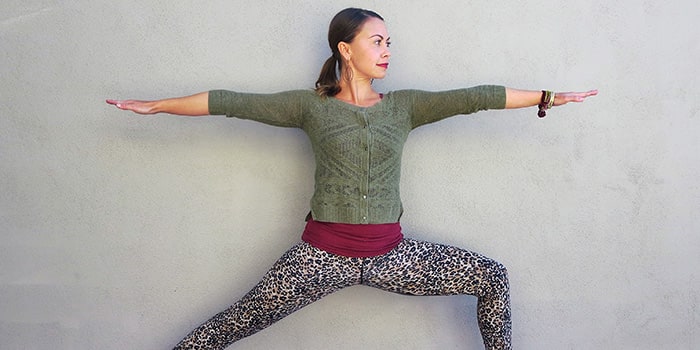
There are many reasons to try yoga, such as to increase flexibility, build strength, relieve muscle tightness, reduce stress, and much more. The best part is, you can receive these benefits even with beginner yoga poses. A great place to start is BODi’s 3 Week Yoga Retreat. In this beginner yoga program, four yoga experts guide you through the fundamentals of yoga.
8 Easy Yoga Poses and How To Do Them:
1. Mountain Pose (Tadasana)
It doesn’t look like much, but mountain pose is a very important pose since it’s alignment is the blueprint for many other poses in yoga.
- Stand with your big toes touching and heels slightly apart, or feet parallel and hip-width apart.
- Flex the quadriceps upward and rotate the upper thigh muscles inward.
- Engage abdominals toward the spine and tilt your tailbone downward.
- Expand the chest and pull your shoulders back and down.
- Bring chin parallel to the floor.
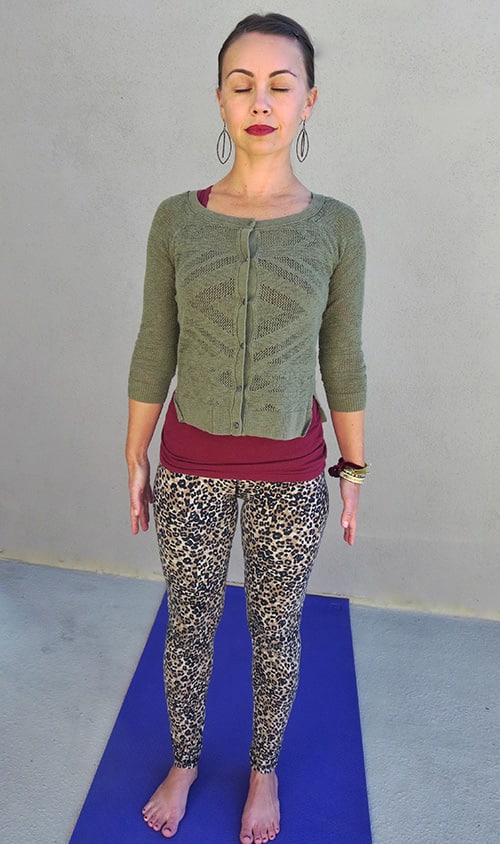
2. Standing Forward Bend (Uttanasana)
Standing forward bend is a natural transition from mountain pose and stretches the entire back of the body — from the calves and hamstrings, to the lower and upper back.
- Begin with feet hip-width apart.
- Hinge forward from the hips and bring the torso toward the legs, keeping the spine straight.
- Bend your knees slightly so that your stomach touches your thighs.
- Reach your hands toward the floor, and let your head hang.
- Slowly try to straighten the knees while keeping your stomach on your thighs.
- With your hands on the floor or your ankles, hold the pose and take five full breaths.
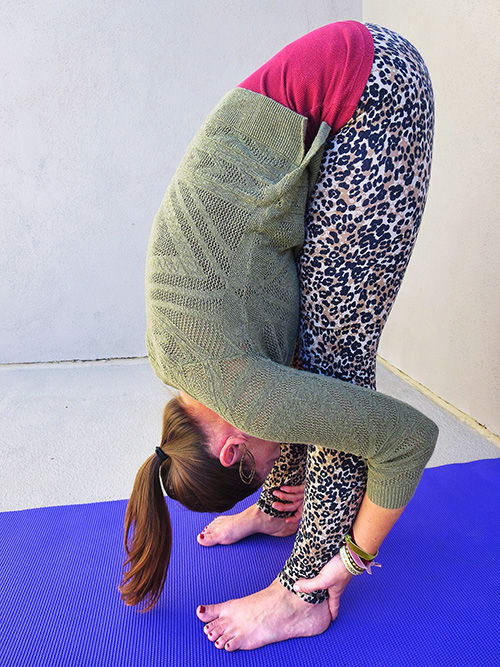
3. Warrior II (Virabhadrasana II)
Warrior II strengthens and stretches the body at the same time, giving you the feeling of a strong, fierce warrior. This pose strengthens your ankles, legs, glutes, core, back, and shoulders.
- Stand with feet 3-4 feet apart with the front foot pointing straight ahead and the back foot at 45 degrees or parallel to the back edge of the mat. Align the front foot’s heel with the back foot’s arch.
- Keeping your back leg straight, bend your front knee so that it is directly above the ankle and creating a 90-degree angle at the knee.
- Engage abdominals toward the spine and tilt your tailbone downward.
- Align your shoulders over your hips and reach arms out so they are parallel to the floor.
- Draw shoulders down and back away from the ears, lengthen your neck and look over your front hand.
- Hold for five breaths, then repeat on the other side.
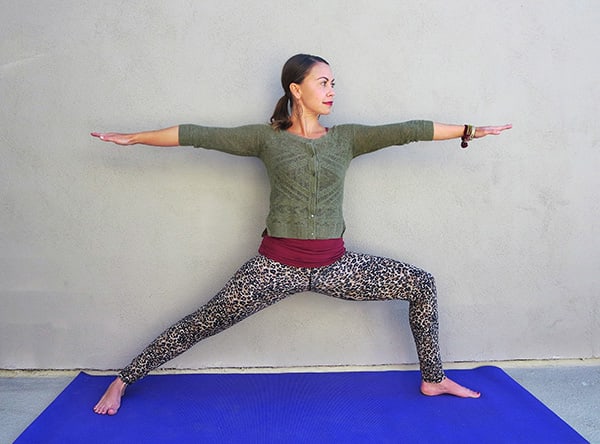
4. Tree Pose (Vrksasana)
Tree pose is the perfect beginner yoga pose for balancing — once you’ve mastered tree pose, you can move on to more complicated balancing poses. Tree pose strengthens the muscles of the standing leg, ankle, and foot. Tree pose also helps calm the mind.
- Start in mountain pose with your feet hip-distance apart.
- Keeping your hands at your hips, slowly press the sole of one foot into the standing ankle, calf muscle, or inner thigh (avoid the knee).
- To help with balance, press the foot into the leg and the leg into the foot, and focus your gaze on a non-moving spot on the ground.
- Once you feel stable, press your hands together in front of your chest or raise them above your head.
- Hold for five full breaths, then repeat on the other side.
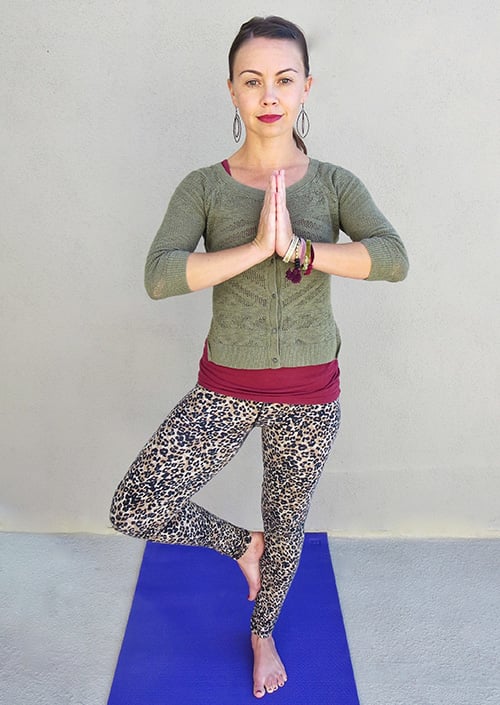
5. Reverse Warrior (Viparita Virabhadrasana)
This pose is similar to Warrior II, except there’s an added stretch for the side of the body.
- Start in warrior II pose.
- Engage abdominals toward the spine and tilt your tailbone downward.
- Place the back hand on your back thigh as you reach your front arm up and over the head without bending the elbow.
- Hold for five full breaths, then repeat on the other side.
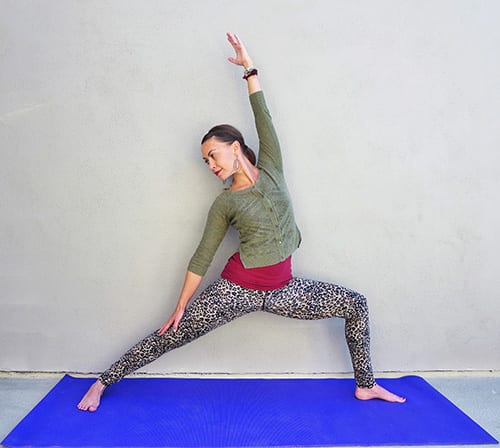
6. Extended Side Angle (Utthita Parsvakonasana)
Extended side angle is a good pose to perform right after reverse warrior since it stretches the opposite side of the body. This pose strengthens the calves, quads, hamstrings, and groin, while stretching the legs, hips, waist, shoulders, and arms.
- Start in reverse warrior or warrior II pose.
- Place your front elbow onto your front quad, palm faced up.
- Engage abdominals toward the spine and tilt your tailbone downward.
- Reach the back arm directly over your head without bending the elbow, keeping your bicep close to your ear.
- Draw the shoulders back and down to create space between shoulders and ears.
- Create a straight line from the outer edge of the back foot to the fingertips of the top hand.
- Hold for five full breaths, then repeat on other side.
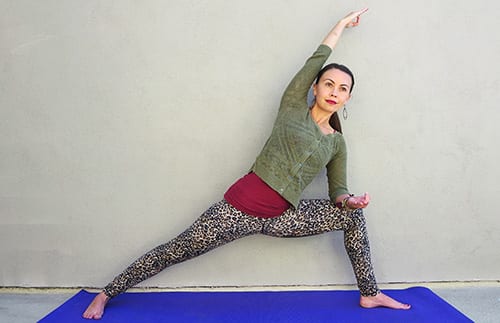
7. Triangle Pose (Utthita Trikonasana)
Triangle pose may look easy, but if you have tight hamstrings or hips, you may find it challenging. That doesn’t mean it’s not for beginners. It just may take some time to perfect.
- Start with your feet 3 feet apart (a slightly shorter stance than warrior II). Point the front foot straight ahead and the back foot at 45 degrees or parallel to the back edge of the mat. Align the front foot’s heel with the back foot’s arch.
- Reach your arms straight out in a “T” formation and straighten both legs.
- Press into your feet, engage the quads, engage abdominals toward the spine, and tilt your tailbone downward.
- Shift your rib cage forward, extending your front arm as far as you can reach in front of you.
- Tilt sideways from the waist, bringing your front fingertips toward your front ankle and your back arm up to the ceiling.
- Rotate the chest open to stack the shoulders and bring the arms into a straight line.
- The front hand may be placed on the shin, ankle, in front or in back of the calf, or on a block.
- Turn your head to look at your top hand.
- Hold for five full breaths, then repeat on other side.
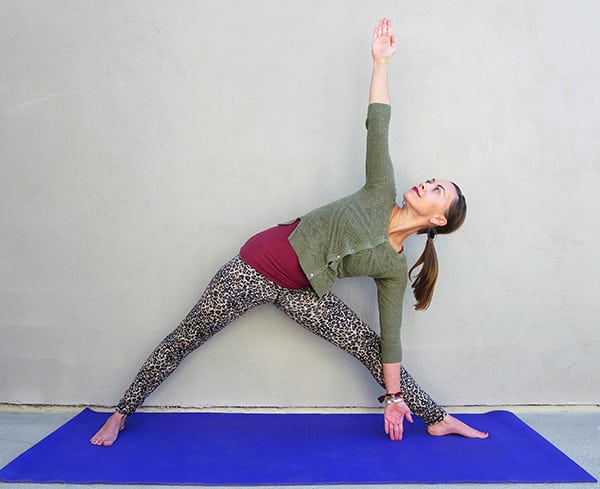
8. Downward Dog (Adho Mukha Svanasana)
This classic beginner yoga pose is one of the first poses that new yogis learn. Downdog is part of the warm up for most yoga classes and provides a great stretch for the back and the legs, while building strength in the shoulders and arms.
- Begin on your hands and knees, with shoulders over wrists and hips over knees.
- Press into your hands and lift your hips up and back. Keep a slight bend in the knees.
- Spread your fingers, straighten your arms, rotate your shoulders outward and away from the ears, engage the core, and lift the hips high.
- Rotate your upper thighs inward, straighten the legs and lower your heels toward the floor.
- Relax the neck and let the head hang. Hold for five full breaths.
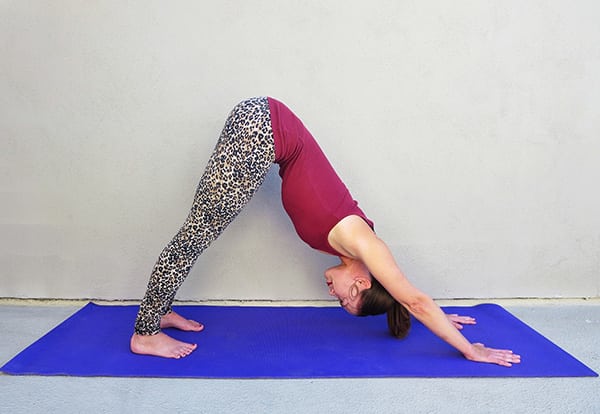
Photos by Lulu Lam
